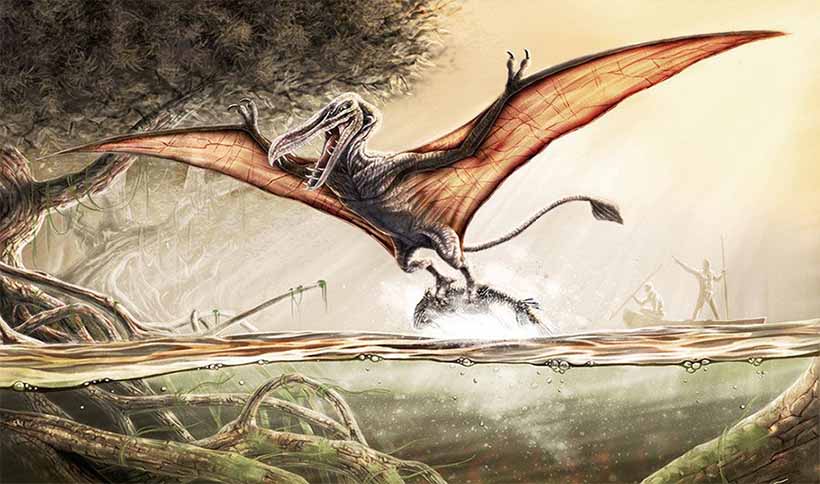The Native American Thunderbird Legend
Kongamato Mythology ?

From time immemorial, accounts relate the observation, in Indonesia, in Africa, in Australia and on the two American subcontinents, of immense winged creatures. Cryptozoologists have mainly focused on the African kongamato and the Native American thunderbird. Current theories now advocate the manifestation of flying objects of extraterrestrial origin.
Kongamato

According to cryptozoologists, the kongamato is a pterodactyl with a wingspan of 1.20 and 2.10 meters, and which still lives in the marshes of Jiundu, in the western zone of Zaire. Deprived of feathers, it would sport a smooth skin of red or black shade and a long beak pricked with teeth. The name of this creature was given to it by the natives, of which it would capsize the fishing canoes during its hunting. Furthermore, according to popular mythology, it would bring death to all who saw it.
In 1923, members of the Kaonde tribe confided to British explorer Frank H. Melland that there was a "swamp demon". Trying to identify the animal, the British show several representations of pterodactyl to the natives. These, it is said, would have formally and without hesitation recognized their kongamato. A few years later, journalist J. Ward Price and the future King Edward VIII set off on an expedition to the English colonies in Africa. Near the Jiundu swamps, they find a native, suffering from deep wounds in the back. A huge bird with large teeth would have inflicted this treatment on him. This man will also formally identify his attacker on drawings of pterodactyls. In 1957, when he was admitted to the hospital, a man seriously injured in the chest said that he had been attacked by a huge bird in the swamps of Bangweulu, Rhodesia. When drawing his attacker, the sketch shows the silhouette of a pterodactyl. Various observations will be made until the end of the 1950s, in the regions mentioned. However, a photo of a kongamato will turn out, after analysis, to be a trick.
For the moment, it is impossible to determine the origin of the phenomenon of kongamato. Zoologists believe that it is a shoebill, an African bird close to storks, which lives in these swamps. However, no attacks on humans have been reported to date. Other explanations have turned to the existence of very large bats, which have not yet been listed. Cryptozoologists are however of the opinion that it is a pterodactyl, unfairly considered as an extinct species.
Thunderbird myth
The native american thunderbird is the mythological version of the African kongamato. Since the earliest times of the settlement of the territory, large flying animals have been regularly observed, especially in the northern American states where one can really speak of a wave of comings. Cryptozoologists, and in particular the American researcher Ivan T. Sanderson, consider that the thunderbird animal would be a survival of pterodactyl, just like its African parent. However, the only prehistoric flying animal imaginable here would be a specimen of the family of the American Teratornithidae, now extinct. These are the immense ancestors of the current vultures, the largest of which had a wingspan of 8 meters.
For the identification of these birds, some scientists approach pre-astronautical theses and even go so far as to suggest that thunderbird mythology is based on prehistoric observations of flying objects of extraterrestrial origin.









































































































































































































































































































































